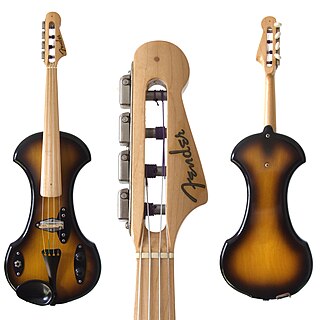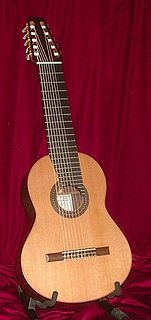
The bass guitar, electric bass or simply bass, is the lowest-pitched member of the guitar family. It is a plucked string instrument similar in appearance and construction to an electric or an acoustic guitar, but with a longer neck and scale length, and typically four to six strings or courses. Since the mid-1950s, the bass guitar has largely replaced the double bass in popular music.

The double bass, also known simply as the bass, is the largest and lowest-pitched bowed string instrument in the modern symphony orchestra. Similar in structure to the cello, it has four, although occasionally five, strings.

An electric guitar is a guitar that requires external amplification in order to be heard at typical performance volumes, unlike a standard acoustic guitar. It uses one or more pickups to convert the vibration of its strings into electrical signals, which ultimately are reproduced as sound by loudspeakers. The sound is sometimes shaped or electronically altered to achieve different timbres or tonal qualities on the amplifier settings or the knobs on the guitar from that of an acoustic guitar. Often, this is done through the use of effects such as reverb, distortion and "overdrive"; the latter is considered to be a key element of electric blues guitar music and rock guitar playing.

The guitar is a fretted musical instrument that typically has six strings. It is held flat against the player's body and played by strumming or plucking the strings with the dominant hand, while simultaneously pressing selected strings against frets with the fingers of the opposite hand. A plectrum or individual finger picks may also be used to strike the strings. The sound of the guitar is projected either acoustically, by means of a resonant chamber on the instrument, or amplified by an electronic pickup and an amplifier.

Music is the art of arranging sounds in time through the elements of melody, harmony, rhythm, and timbre. It is one of the universal cultural aspects of all human societies. General definitions of music include common elements such as pitch, rhythm, dynamics, and the sonic qualities of timbre and texture. Different styles or types of music may emphasize, de-emphasize or omit some of these elements. Music is performed with a vast range of instruments and vocal techniques ranging from singing to rapping; there are solely instrumental pieces, solely vocal pieces and pieces that combine singing and instruments. The word derives from Greek μουσική, mousiké, '(art) of the Muses'.

A steel guitar is any guitar played while moving a steel bar or similar hard object against plucked strings. The bar itself is called a "steel" and is the source of the name "steel guitar". The instrument differs from a conventional guitar in that it is played without using frets; conceptually, it is somewhat akin to playing a guitar with one finger. Known for its portamento capabilities, gliding smoothly over every pitch between notes, the instrument can produce a sinuous crying sound and deep vibrato emulating the human singing voice. Typically, the strings are plucked by the fingers of the dominant hand, while the steel tone bar is pressed lightly against the strings and moved by the opposite hand.

The washtub bass, or gutbucket, is a stringed instrument used in American folk music that uses a metal washtub as a resonator. Although it is possible for a washtub bass to have four or more strings and tuning pegs, traditional washtub basses have a single string whose pitch is adjusted by pushing or pulling on a staff or stick to change the tension.

String instruments, stringed instruments, or chordophones are musical instruments that produce sound from vibrating strings when a performer plays or sounds the strings in some manner.
A bass musical instrument produces tones in the low-pitched range C4- C2. Basses belong to different families of instruments and can cover a wide range of musical roles. Since producing low pitches usually requires a long air column or string, the string and wind bass instruments are usually the largest instruments in their families or instrument classes.

An electric violin is a violin equipped with an electronic output of its sound. The term most properly refers to an instrument intentionally made to be electrified with built-in pickups, usually with a solid body. It can also refer to a violin fitted with an electric pickup of some type, although "amplified violin" or "electro-acoustic violin" are more accurate in that case.

The pedal steel guitar is a console-type of steel guitar with pedals and knee levers that change the pitch of certain strings to enable playing more varied and complex music than any previous steel guitar design. Like all steel guitars, it can play unlimited glissandi and deep vibrati—characteristics it shares with the human voice. Pedal steel is most commonly associated with American country music and Hawaiian music.

The lap steel guitar, also known as a Hawaiian guitar, is a type of steel guitar without pedals that is typically played with the instrument in a horizontal position across the performer's lap. Unlike the usual manner of playing a traditional acoustic guitar, in which the performer's fingertips press the strings against frets, the pitch of a steel guitar is changed by pressing a polished steel bar against plucked strings. Though the instrument does not have frets, it displays markers that resemble them. Lap steels may differ markedly from one another in external appearance, depending on whether they are acoustic or electric, but in either case, do not have pedals, distinguishing them from pedal steel guitar.

A rhythm section is a group of musicians within a music ensemble or band that provides the underlying rhythm, harmony and pulse of the accompaniment, providing a rhythmic and harmonic reference and "beat" for the rest of the band. The rhythm section is often contrasted with the roles of other musicians in the band, such as the lead guitarist or lead vocals whose primary job is to carry the melody.

The Fender Musical Instruments Corporation is an American manufacturer of instruments and amplifiers. Fender produces acoustic guitars, bass amplifiers and public address equipment, but is best known for its solid-body electric guitars and bass guitars, particularly the Stratocaster, Telecaster, Jaguar, Jazzmaster, Precision Bass, and the Jazz Bass. The company was founded in Fullerton, California by Clarence Leonidas "Leo" Fender in 1946. Its headquarters are in Los Angeles, California.

Acoustic music is music that solely or primarily uses instruments that produce sound through acoustic means, as opposed to electric or electronic means. While all music was once acoustic, the retronym "acoustic music" appeared after the advent of electric instruments, such as the electric guitar, electric violin, electric organ and synthesizer. Acoustic string instrumentations had long been a subset of popular music, particularly in folk. It stood in contrast to various other types of music in various eras, including big band music in the pre-rock era, and electric music in the rock era.

Stagg music is a Belgian musical instrument company headquartered in Brussels, currently a subsidiary of EMD Music. The company produce a wide range of musical instruments, which includes string instruments, percussion instruments, tuned metal, free reed and brass instruments as well as effects units and other accessories.
A music store or musical instrument store is a retail business that sells musical instruments and related equipment and accessories. Some music stores sell additional services, such as music lessons, music instrument or equipment rental, or repair services.

There are many varieties of ten-string guitar, including:

This is a list of jazz and popular music terms that are likely to be encountered in printed popular music songbooks, fake books and vocal scores, big band scores, jazz, and rock concert reviews, and album liner notes. This glossary includes terms for musical instruments, playing or singing techniques, amplifiers, effects units, sound reinforcement equipment, and recording gear and techniques which are widely used in jazz and popular music. Most of the terms are in English, but in some cases, terms from other languages are encountered.

Music technology is the study or the use of any device, mechanism, machine or tool by a musician or composer to make or perform music; to compose, notate, play back or record songs or pieces; or to analyze or edit music.


















